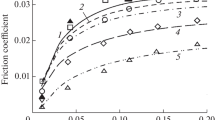Abstract
The paper reports the empirical observations of voltage generation in a lubricated tribocontact with different oils altering load, sliding and temperature. The investigation is done in the context of research of the root cause of white etching cracks (WEC) failure in bearings. Tested oils of different additive packages found completely different electrical behavior. The oil, which is known to produce WECs in laboratory tests, demonstrated non-zero voltage generation.








Similar content being viewed by others
References
Evans, M.-H.: An updated review: white etching cracks (WECs) and axial cracks in wind turbine gearbox bearings. Mater. Sci. Technol. 32, 1133–1169 (2016)
Gould, B., Greco, A., Stadler, K., Xiao, X.: An analysis of premature cracking associated with microstructural alterations in an AISI 52100 failed wind turbine bearing using X-ray tomography. Mater. Des. 117, 417–429 (2017). doi:10.1016/j.matdes.2016.12.089
Loos, J., Bergmann, I., Goss, M.: Influence of currents from electrostatic charges on WEC formation in rolling bearings. Tribol. Trans. 59, 865–875 (2016). doi:10.1080/10402004.2015.1118582
Lu, W.J., Qin, R.S.: Stability of martensite with pulsed electric current in dual-phase steels. Mater. Sci. Eng. A 677, 252–258 (2016). doi:10.1016/j.msea.2016.08.123
Dai, W., Wang, X., Zhao, H., Zhao, X.: Effect of electric current on microstructural evolution in a cold-rolled 3% Si steel. Mater. Trans. 53, 229–233 (2012)
Holweger, W., Wolf, M., Walther, F., Trojahn, W., Mütze, A., Kunzmann, J., Schreiber, J., Mayer, J., Reichelt, M.: Studies of the contribution of alternating electromagnetic fields toward material fatigue in 100Cr6. Ind Lubr Tribol. 64, 247–252 (2012)
Kang, J.-H., Hosseinkhani, B., Williams, C.A., Moody, M.P., Bagot, P.A.J., Rivera-Díaz-del-Castillo, P.E.J.: Solute redistribution in the nanocrystalline structure formed in bearing steels. Scr. Mater. 69, 630–633 (2013)
West, O.H.E., Diederichs, A.M., Alimadadi, H., Dahl, K.V., Somers, M.A.: Application of complementary techniques for advanced characterization of white etching cracks. Pract. Metallogr. 50, 410–431 (2013)
Grabulov, A., Petrov, R., Zandbergen, H.W.: EBSD investigation of the crack initiation and TEM/FIB analyses of the microstructural changes around the cracks formed under Rolling Contact Fatigue (RCF). Int. J. Fatigue 32, 576–583 (2010)
Gould, B., Greco, A.: Investigating the process of white etching crack initiation in bearing steel. Tribol. Lett. 62, 1–14 (2016)
Diederichs, A.M., Barteldes, S., Schwedt, A., Mayer, J., Holweger, W.: Study of subsurface initiation mechanism for white etching crack formation. Mater. Sci. Technol. 32, 1170–1178 (2016). doi:10.1080/02670836.2016.1155842
Becker, P.C.: Microstructural changes around non-metallic inclusions caused by rolling-contact fatigue of ball-bearing steels. Met. Technol. 8, 234–243 (1981)
Gegner, J.: Tribological aspects of rolling bearing failures. INTECH Open Access Publisher, Rijeka (2011)
Ščepanskis, M., Jakovičs, A., Kaldre, I., Holweger, W., Nacke, B., Diederichs, A.M.: The numerical model of electrothermal deformations of carbides in bearing steel as the possible cause of white etching cracks initiation. Tribol. Lett. 59, 1–10 (2015)
Evans, M.-H., Wang, L., Wood, R.: Formation mechanisms of white etching cracks and white etching area under rolling contact fatigue. Proc. Inst. Mech. Eng. Part J J. Eng. Tribol. 228, 1047–1062 (2014). doi:10.1177/1350650114525363
Gould, B., Greco, A.: The influence of sliding and contact severity on the generation of white etching cracks. Tribol. Lett. 60, 1–13 (2015)
Holweger, W., Wolf, M., Merk, D., Blass, T., Goss, M., Loos, J., Barteldes, S., Jakovics, A.: White etching crack root cause investigations. Tribol. Trans. 58, 59–69 (2015)
Evans, M.-H., Richardson, A.D., Wang, L., Wood, R.J.K., Anderson, W.B.: Confirming subsurface initiation at non-metallic inclusions as one mechanism for white etching crack (WEC) formation. Tribol. Int. 75, 87–97 (2014)
Evans, M.-H., Richardson, A.D., Wang, L., Wood, R.J.K.: Serial sectioning investigation of butterfly and white etching crack (WEC) formation in wind turbine gearbox bearings. Wear 302, 1573–1582 (2013)
Ruellan, A., Cavoret, J., Ville, F., Kleber, X., Liatard, B.: Understanding white etching cracks in rolling element bearings: state of art and multiple driver transposition on a twin-disc machine. Proc. Inst. Mech. Eng. Part J J. Eng. Tribol. 231, 203–220 (2017). doi:10.1177/1350650116648058
Mikami, H., Kawamura, T.: Influence of electrical current on bearing flaking life. SAE technical paper (2007)
Ruellan, A.: Tribological analysis of White Etching Crack (WEC) failures in rolling element bearings. https://tel.archives-ouvertes.fr/tel-01153235/ (2014)
Tamada, K., Tanaka, H.: Occurrence of brittle flaking on bearings used for automotive electrical instruments and auxiliary devices. Wear 199, 245–252 (1996)
Holweger, W.: Progresses in solving white etching crack phenoma. NREL Gearbox Reliab. Collab. Gold. Colo. 45 (2014)
Ščepanskis, M., Jakovičs, A., Holweger, W., Nacke, B.: The hypothesis and the numerical model of electromagnetic impact on white etching cracks in bearing steel. In: Tribology Frontiers Conference, Denver, Colorado (2015)
Booser, E.R.: Tribology data handbook: an excellent friction, lubrication, and wear resource. CRC Press, Cambridge (1997)
Darma, I.S.: Others: dielectric properties of mixtures between mineral oil and natural ester from palm oil. World Sci. Eng. Acad. Soc. WSEAS Trans. Power Syst. 3, 37–46 (2008)
Carey, A.A.: The dielectric constant of lubrication oils. DTIC Document (1998)
Acknowledgements
The work was done during the research scholar of Dr. Mihails Ščepanskis at Argonne National Laboratory (October 2015–March 2016). The scholar was funded by the Baltic-American Freedom Foundation. This work is also supported by the U.S. Department of Energy Office of Energy Efficiency and Renewable Energy, Wind Energy Technology Office under Contract No. DE-AC02-06CH11357. The authors would like to acknowledge Dr. Marc Ingram and Afton Chemical for providing formulated oils and useful discussion. The authors also like to acknowledge Dr. Robert Erck (ANL) for valuable support in preparation of the experiment. The principle idea of the presented experiment was generated during the discussion between Dr. Mihails Ščepanskis and Dr. Walter Holweger (Schaeffler) in July 2015.
Author information
Authors and Affiliations
Corresponding author
Rights and permissions
About this article
Cite this article
Ščepanskis, M., Gould, B. & Greco, A. Empirical Investigation of Electricity Self-Generation in a Lubricated Sliding–Rolling Contact. Tribol Lett 65, 109 (2017). https://doi.org/10.1007/s11249-017-0892-y
Received:
Accepted:
Published:
DOI: https://doi.org/10.1007/s11249-017-0892-y



